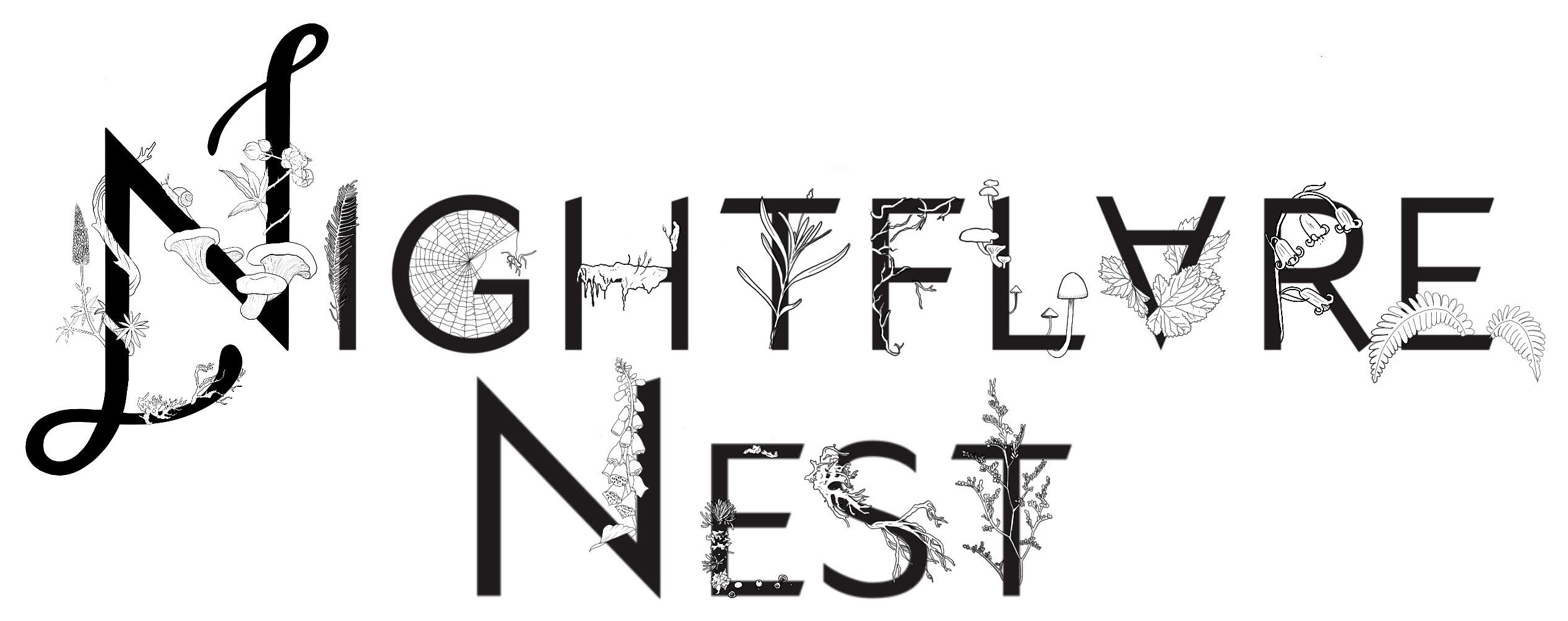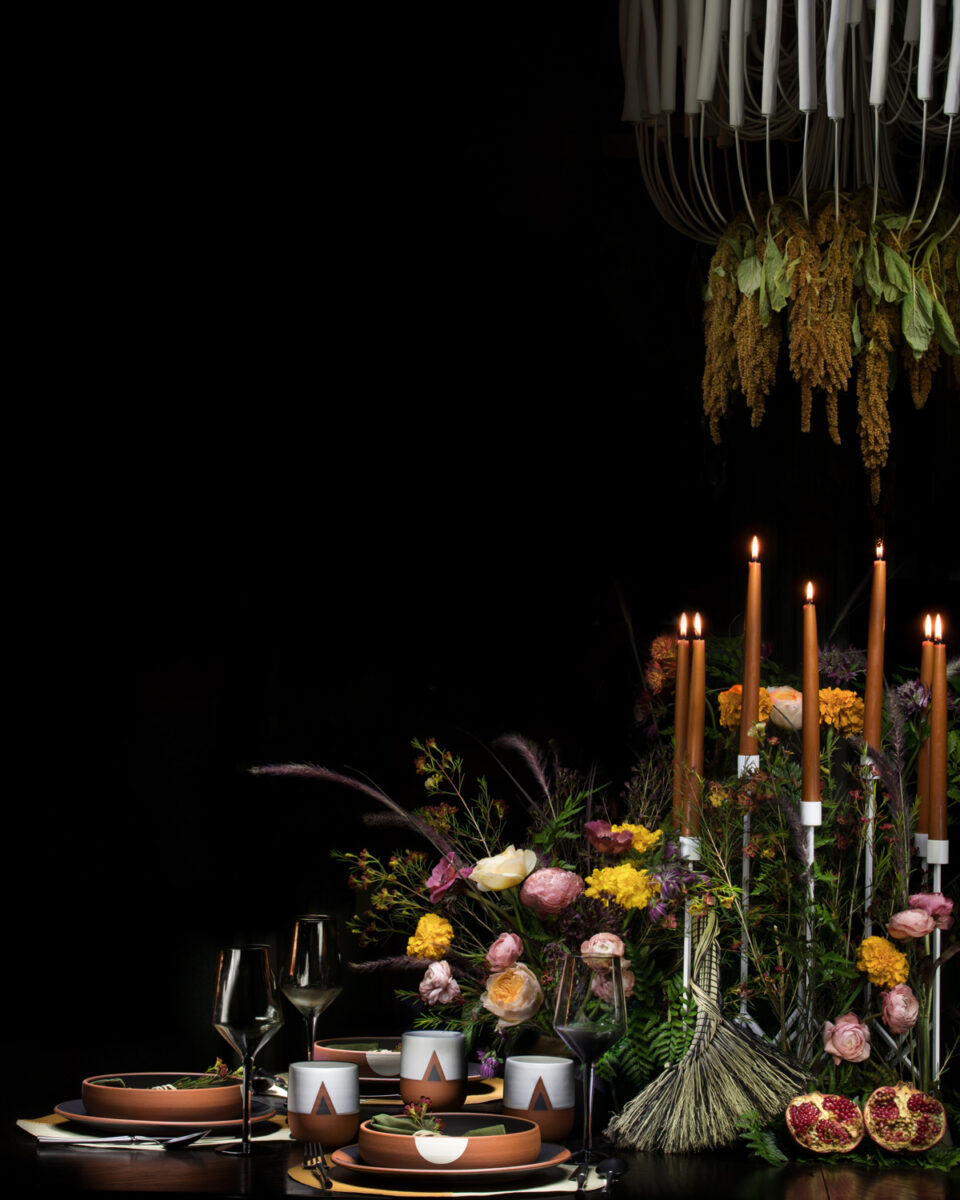Samhain, The Night of Magic and Chaos, also called Feast of the Dead, Feast of Apples, November Eve, Hallow’s Eve, All Hallow’s Eve and Halloween.
Happy 31st. When daylight eludes and darkness falls, it’s time to grab your firewood. The blue full moon is out. With a glowing line of candlelight, you follow the guided path with offerings, side by side with the spirits, to gather, build, create and ignite bonfires. This is where the veil starts to lift and the worlds of the living and the un-living collide. Dance together, feast upon the last harvest. Frost is upon us, so soak this up. Let us all run wild as we honor the Dark Mother and the Dark Father.
We are both Tauruses and like many, we were really looking forward to the Taurus blue full moon on Samhain. Drew’s first word was ‘moon’; she’s always felt so connected and as a small baby would make her parents go outside with her every night so she could see that warm glow and the moon would just soothe her. Things have not changed. Since we sadly can’t be with chosen loved ones and are self isolating in 2020, we decided to make a lavish Samhain feast, with all the food, botanical offerings and a third table setting for ancestors.
Our Samhain Feast Design + Fall Style Guide, which will come out in early November, was conceived to be more on the modern moody pagan side. We chose one of our favorite local ceramicists, Wolf Ceramics and had custom dining ware made.
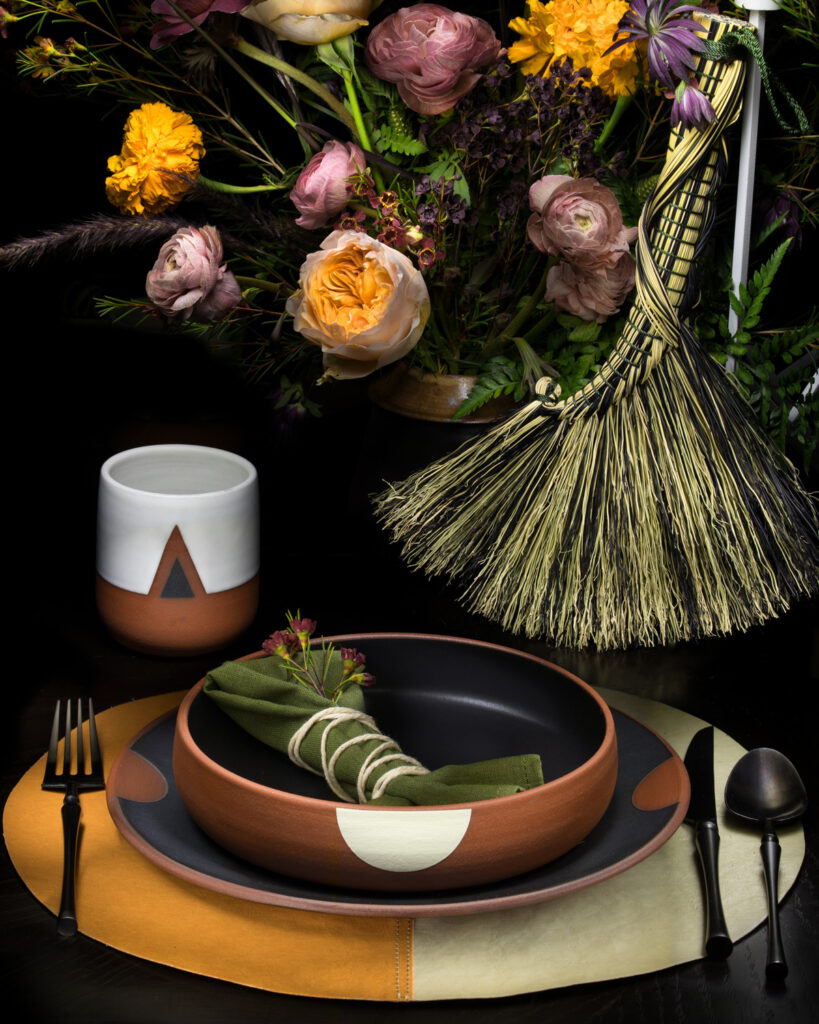
We paired a mix of dark, light and warm tones of a bonfire with lush botanicals. Our Style guide will delve further into what exact botanicals we used, our color palate selections, and where we sourced our dinnerware. Subscribe to our mailing list so you can be the first to receive our Fall Style Guide.
Now tonight, as the full moon glows into our little hidden house that sits up upon a bluff, we chose to celebrate this special occasion with these unique dishes.
Nightflare Nest Samhain Feast Menu
Cocktail
Rye + Mead + Veil Tea
First Course
Turnip Pureé + Miso Roasted Carrots + Horseradish Cream + Crispy Buckwheat + Marigold Greens
Main Course
Mead + Pomegranate Glazed Chicken w/ Sage Apple Cream Sauce
Chamomile + Honey Corn Bread
Rosemary Fried Rice + Chanterelle Mushroom Confit
Dessert
Hazelnut Cake + Squash Mousse + Sage Apple Butter + Star Anise Buttercream
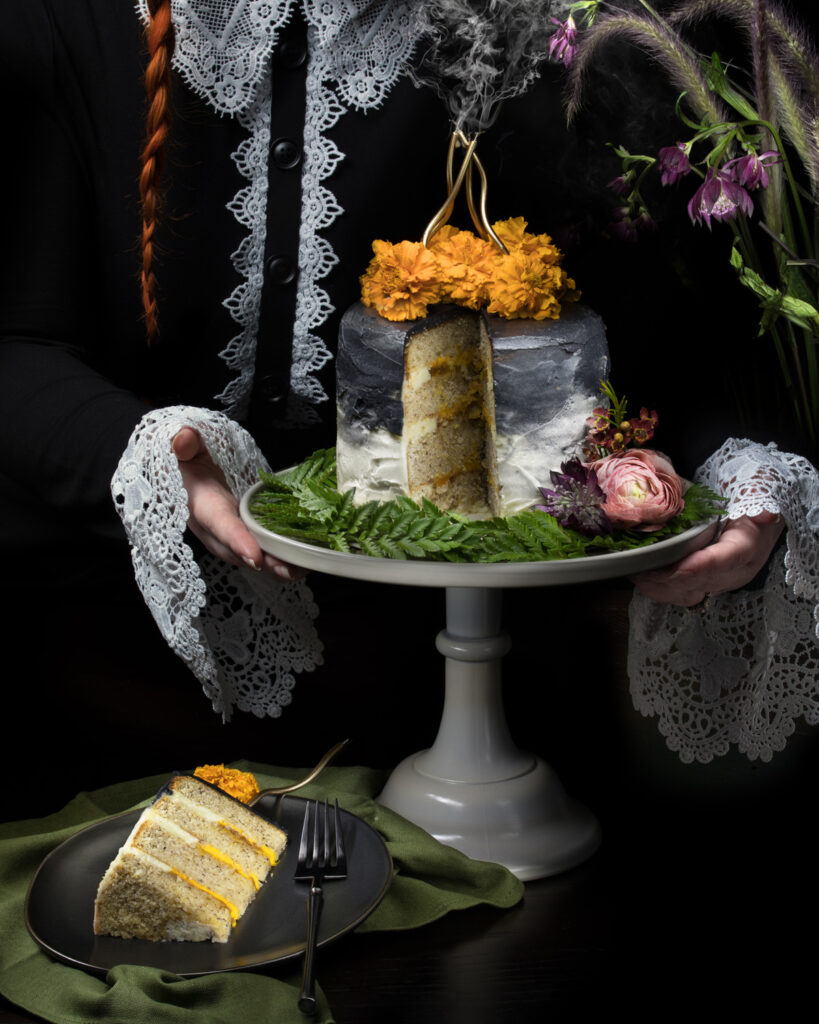
What are the origins of Samhain?
In Celtic mythologySamhain which is Gaelic and is pronounced “Sow-wan” is a pagan holiday celebrated on the evening of October 31st that started 20,000 years ago in Ireland. It was the most significant of one of our four Greater Sabbats, which was between the fall equinox and the winter solstice. This was thought of to be the time of year the veil between the living and dead grew thin and the worlds started to collide. Samhain was a very important festival and was the last of the 3 harvests. In modern paganism it’s considered the “Witch’s New Year,” since it is the end of the harvest season. It is a time of “renewal and spiritual intention-setting.” Samhain the final chance to to stock up on foods, dry herbs for the hibernation of winter, and it was the night when fairies caused mischief. It is also the Day of the Dead for ancient Mexicans the Celts and Egyptians. It was the night to remember our loved ones and honor our ancestors.
A visual of Samhain 2,000 years ago, families in Ireland would either celebrate their last harvest by putting out their fire places and going out in the dark of night, meet up with others and they would all start bonfires. The main attraction around the bonfires were eating, drinking and celebrating, honoring the deceased and the festival of the dark days to come. Others would celebrate in their own homes, with a fire blazing in their fireplace, candlelight and cook food from the last harvest, while wearing costume that protected them from the evil spirits. They would set a table placement for a lost loved one or ancestor to honor them, which was called a “Dumb” dinner. I know we wish it was called something else too. We really encourage when you all have some time to look up the origins of Samhain, you have been celebrating or hearing about Halloween since you were a kid
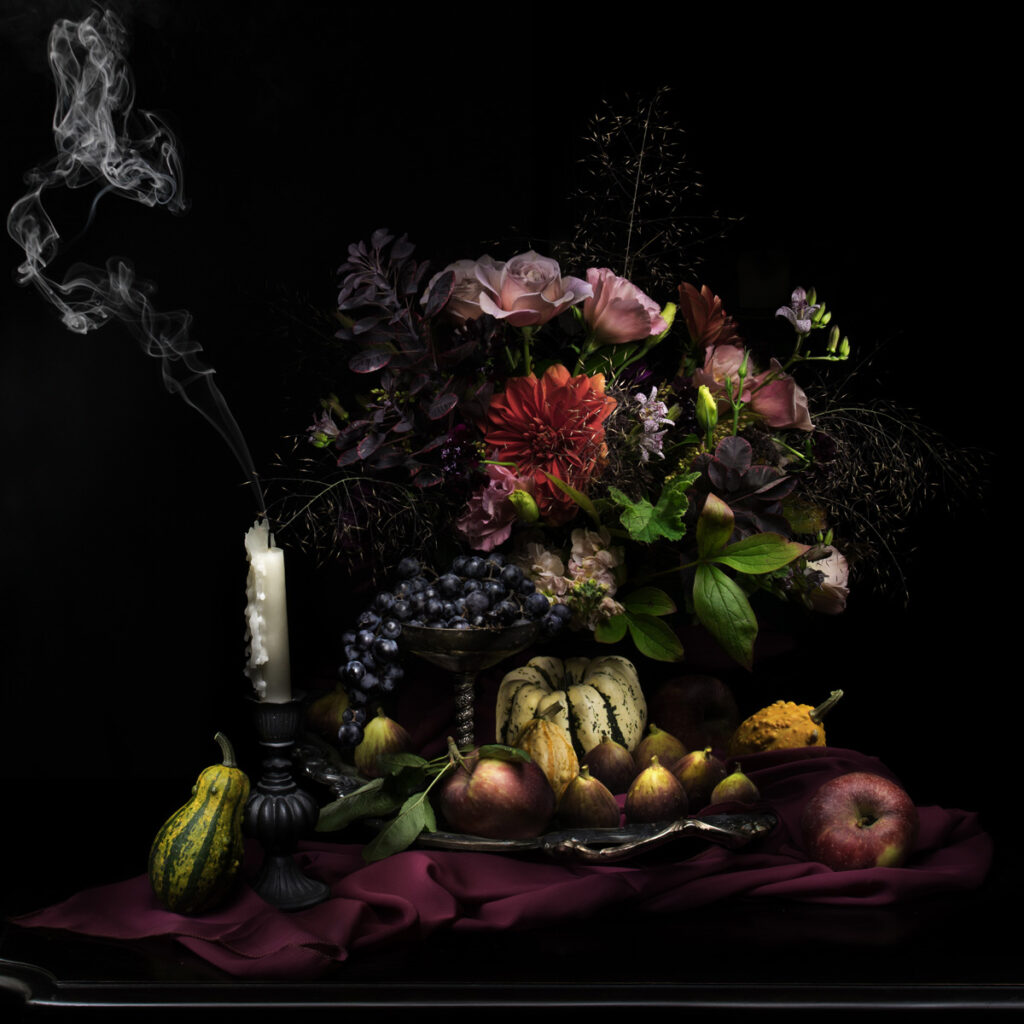
What are some traditions of Samhain?
Samhain Nature Walk. Take a meditative walk in a natural area near your home. Observe and contemplate the colors, aromas, sounds, and other sensations of the season. Experience yourself as part of the Circle of Life and reflect on death and rebirth as being an important part of Nature. If the location you visit permits, gather some natural objects and upon your return use them to adorn your home.
Seasonal Imagery. Decorate your home with Samhain seasonal symbols and the colors of orange and black. Place an Autumnal wreath on your front door. Create displays with pumpkins, cornstalks, gourds, acorns, and apples. Set candles in cauldrons.
Ancestors Altar. Gather photographs, heirlooms, and other mementos of deceased family, friends, and companion creatures. Arrange them on a table, dresser, or other surface, along with several votive candles. Kindle the candles in their memory as you call out their names and express well wishes. Thank them for being part of your life. Sit quietly and pay attention to what you experience. Note any messages you receive in your journal. This Ancestors Altar can be created just for Samhain or kept year round.
Feast of the Dead. Prepare a Samhain dinner. Include a place setting at your table or at a nearby altar for the Dead. Add an offering of a bit of each beverage being consumed to the cup at that place setting, and to the plate, add a bit of each food served. Invite your ancestors and other deceased loved ones to come and dine with you. To have this as a Samhain Dumb Supper experience, dine in silence. After the feast, place the contents of the plate and cup for the Dead outdoors in a natural location as an offering for the Dead.
Ancestor Stories. Learn about family history. Contact one or more older relatives and ask them to share memories of family members now dead. Record them in some way and later write accounts of what they share. Give thanks. Share what you learned and have written with another family member or friend. Add names of those you learned about and wish to honor to your Ancestors Altar.
Cemetery Visit. Visit and tend the gravesite of a loved one at a cemetery. Call to mind memories and consider ways the loved one continues to live on within you. Place an offering there such as fresh flowers, dried herbs, or a libation of water.
Reflections. Reflect on you and your life over the past year. Review journals, planners, photographs, blogs, and other notations you have created during the past year. Consider how you have grown, accomplishments, challenges, adventures, travels, and learnings. Meditate. Journal about your year in review, your meditation, and your reflections.
Renovate. Select an area of your home or life as a focus. Examine it. Re-organize it. Release what is no longer needed. Create a better pattern. Celebrate renewal and transformation.
Bonfire Magic. Kindle a bonfire outdoors when possible or kindle flames in a fireplace or a small cauldron. Write down an outmoded habit that you wish to end and cast it into the Samhain flames as you imagine release. Imagine yourself adopting a new, healthier way of being as you move around the fire clockwise.
Divine Invocations. Honor and call upon the Divine in one or more Sacred Forms associated with Samhain, such as the Crone Goddess and Horned God of Nature. Invite Them to aid you in your remembrance of the Dead and in your understanding of the cycle of life, death, and rebirth. If you have lost loved ones in the past year, ask these Divine Ones to comfort and support you.
Divinatory Guidance. Using Tarot, Runes, Scrying, or some other method of divination, seek and reflect on guidance for the year to come. Write a summary of your process and messages. Select something appropriate to act upon and do it.
Transforming Expressions. If you encounter distortions, misinformation, and/or false, negative stereotypes about Paganism and Samhain in the media, contact the source, express your concerns, and share accurate information. Help eradicate derogatory stereotyping with courteous, concise, and intelligent communications.
Community Connections. Connect with others. Join in a group ritual in your area. Organize a Samhain potluck in your home. Research old and contemporary Samhain customs in books, periodicals, on-line, and through communications with others. Exchange ideas, information, and celebration experiences. Regardless of whether you practice solo or with others, as part of your festivities, reflect for a time on being part of the vast network of those celebrating Samhain around the world.
Selena Fox, Circle Sanctuary
What ingredients are used in Samhain recipes?
As creatives with backgrounds in conceptual art, we tend to be very careful about the ingredients we choose when putting together a feast, especially one with such a rich history of ritual and symbolism as that of Samhain. The myriad ways our ancestors celebrated the harvest feast served as excellent inspiration for our dark culinary escapades. Rest assured that this dinner is carefully curated to reference the significance of tradition while carrying it into our modern day. There are a few earthly ingredients and their variants that you will see repeated throughout the recipes above. Some of them are strictly seasonal, while others are ever available depending on where you call home. Each ingredient’s various iterations showcase their versatility as well as how they compliment each other when combined. Finally, convenience is a happy factor when you consider that these ingredients are often bought in bulk and it is nice when you can utilize more than a small portion of what you purchased. The following components will become warmly familiar to you as sacred Samhain charms while you cook your way through our phantasmagoric banquet.
Apples
As previously mentioned, Samhain is also known as “The Feast Of Apples”. Though in our modern times the crisp fruit is available year-round (often to the detriment of flavor and texture), apples are a fiercely seasonal offering and cannot be extricated from the implication of Autumn no more than Tomatoes from summer. They are mythic to so many cultures, both ancient and modern, from Adam and Eve to George Washington. But we are not here to talk about christians and colonialists. Apples played an especially important part to the early Celts, they were foods of the ‘Otherworld’, a supernatural realm of everlasting youth, beauty, health, abundance and joy. The apple symbolized life and immorality, was the talisman that admitted one into the Otherworld. Multiple divination rituals involving apples took place on Samhain. It was said that if you were to peel a skin of an apple, the length of the unbroken peel would determine the length your life was destined to be. Another practice, called “eating an apple at the glass” involved a cutting an apple into nine pieces in a room with a mirror lit by a single candle. The person would stand with their back to the mirror, eat eight of the nine pieces, then throw the ninth piece over their left shoulder. Turning toward the mirror would reveal their future life partner. An apple cut crosswise reveals a pentagram of sorts in the formations of the seeds, thus cementing its significance in magickal practices as well.
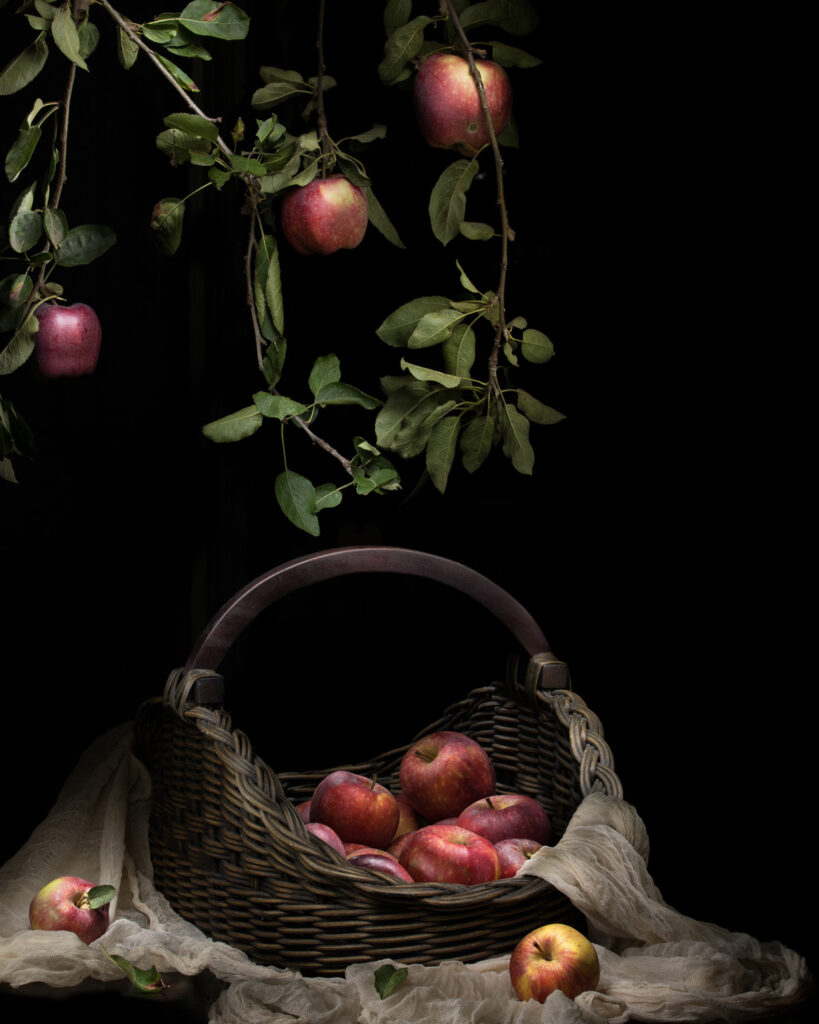
Rosemary
Rosemary happens to be our favorite smell on the planet, at least as far as edible delights are concerned. It’s earthy, woody blend of terpenes and volatile oils are fit for the finest perfume. You will see it in a starring roll in many of our favorite recipes year-round. It is no surprise that the ancients held the herb in similarly high regard. It has long been known as the herb of remembrance, often tossed in graves as a promise to keep the memory of the dead alive. The greeks would wear garlands of rosemary to retain knowledge while studying. It was used on Samhain in a ritual tea that would help lift the veil to the astral plane where one could commune with their ancestors. Rosemary is also valued for its cleansing energy and ability to ward off bad energy and malevolent entities. It was common practice to place the herb over doors and porches to keep those with bad intentions from a home.
Hazelnut
Hazelnuts, also known as filberts, were and are an integral part of Samhain festivities. The eve came upon the third and final nut harvest for the Celts, symbolizing the end of life for the year and descent into the cold dead winter. According to tradition, a single woman would select a hazelnut to represent each of her potential love interests and toss them into the fire. If one nut burned away to ashes, rather than bursting due to the heat of the flames, that would divulge to her the identity of her future husband. A charm of hazelnuts worn around the wrist was used for luck, wish fulfillment and protection. Nuts and fruits were the original trick-or-treat goodies, as 16th century “guisers” dressed in costumes and wandered door to door entertaining their neighbors in exchange for tasty snacks.
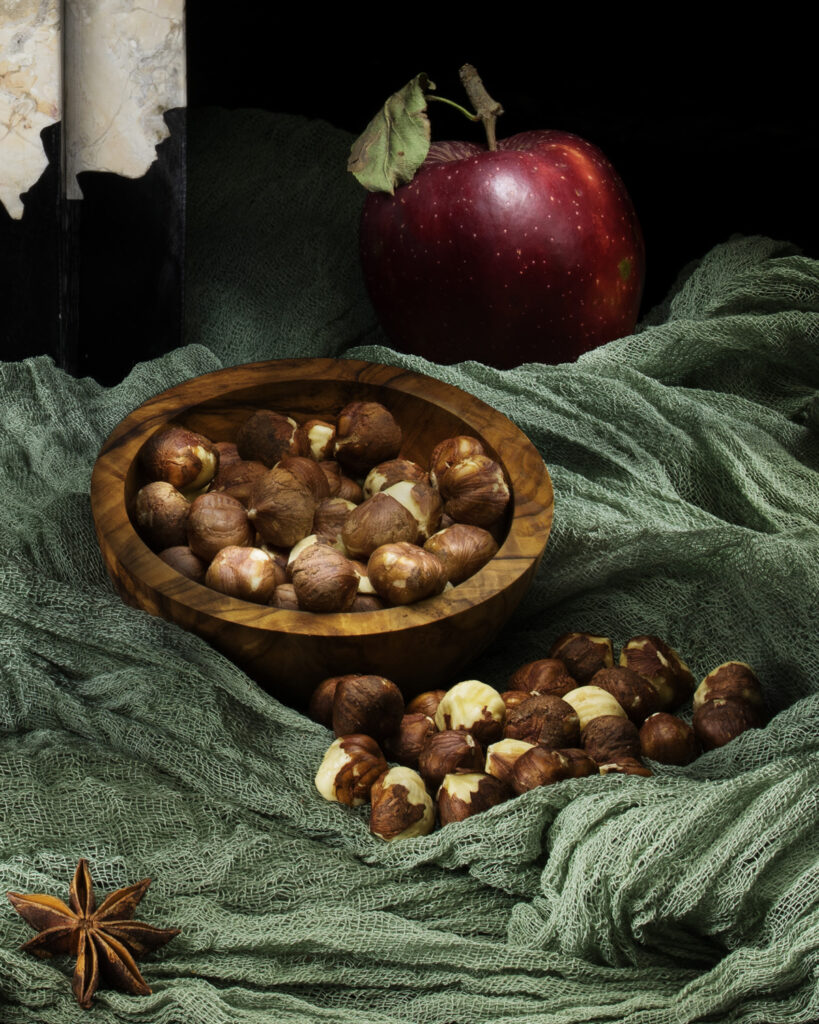
Marigold
Autumn flowers like marigolds are always appropriate for Samhain. Marigolds are associated in many cultures with death and rebirth. In the new world where the ocherous floral hails from, it is the chosen flower of the Mexican Day of the Dead. Much like rosemary, fall flowers were used Samhain as protection against negative energy, strung into garlands and hung on doors. What we were personally unaware of until recently was the distinct herbaceousness of the marigold’s foliage. It is somewhat singular and hard to describe, with a peppery bitterness that lends well to cutting rich dishes. The pedals, while milder, add a beautiful pop of color to otherwise monochromatic dishes.
Mead and Honey
In our modern times we have come to re-appreciate the noble roll of the bee, even and especially as their very existence is threatened on our planet. For beekeepers, Samhain meant hibernation as the queen stops laying and the bees go into their winter cluster, huddling together for warmth until Imbolc arrives in February. Their honey was the original luxury, and mead even predated beer making it the oldest known alcoholic beverage. Mead was a common drink in medieval Ireland, and was often infused with hazelnuts. While no longer widely available, the beverage is worth seeking out. It can be incredibly complex and delicious, fruity, spiced, and floral, fermented with winemaking yeasts and aged in oak casks. Drinking in general was a favorable (and sometimes mandatory!) aspect of Samhain bonfire parties and was valued for it’s veil-lifting properties. After all, they don’t call them spirits for nothing.
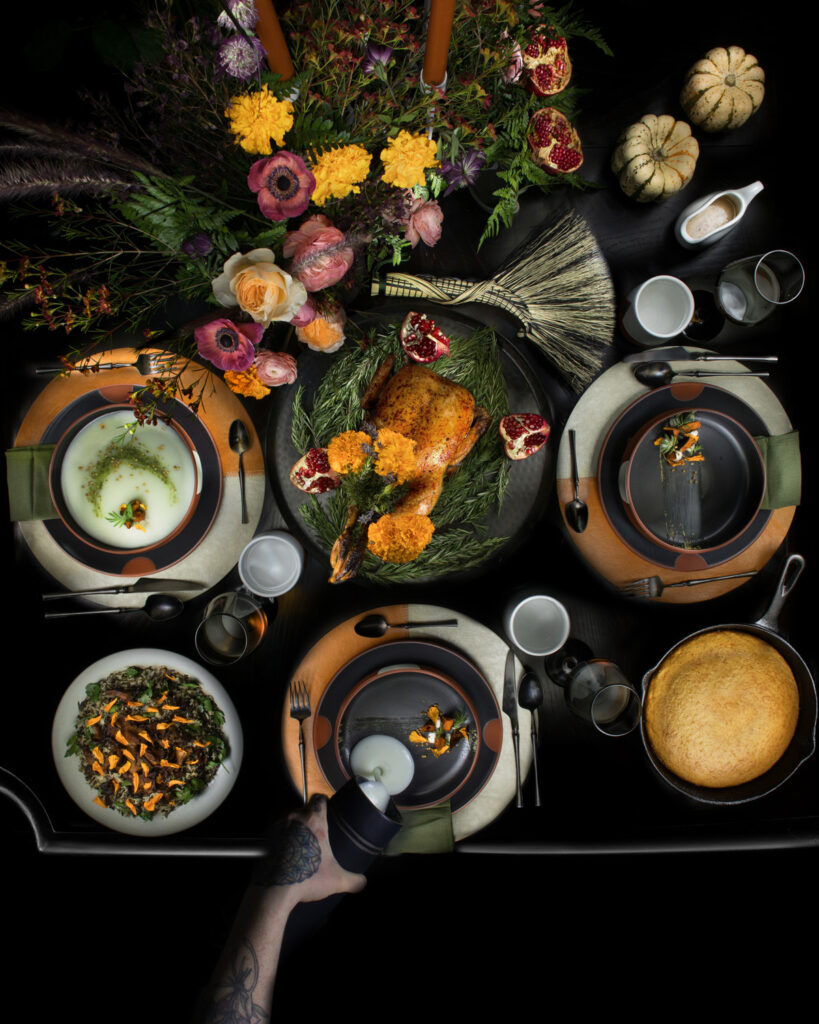
So wherever you are and how ever you are celebrating this luxurious, abundant and spooky day, we hope you bask in this night, make a wonderful meal and marinate in the earthy romanticism that the 31st and the lifting veil has to offer. Happy Night of Magic and Chaos.
Cheers everyone and remember bake with the intention that nature is love and love is food.
Happy Samhain and Blue Full Moon!
-Drew Johanna Night + Nick Night
